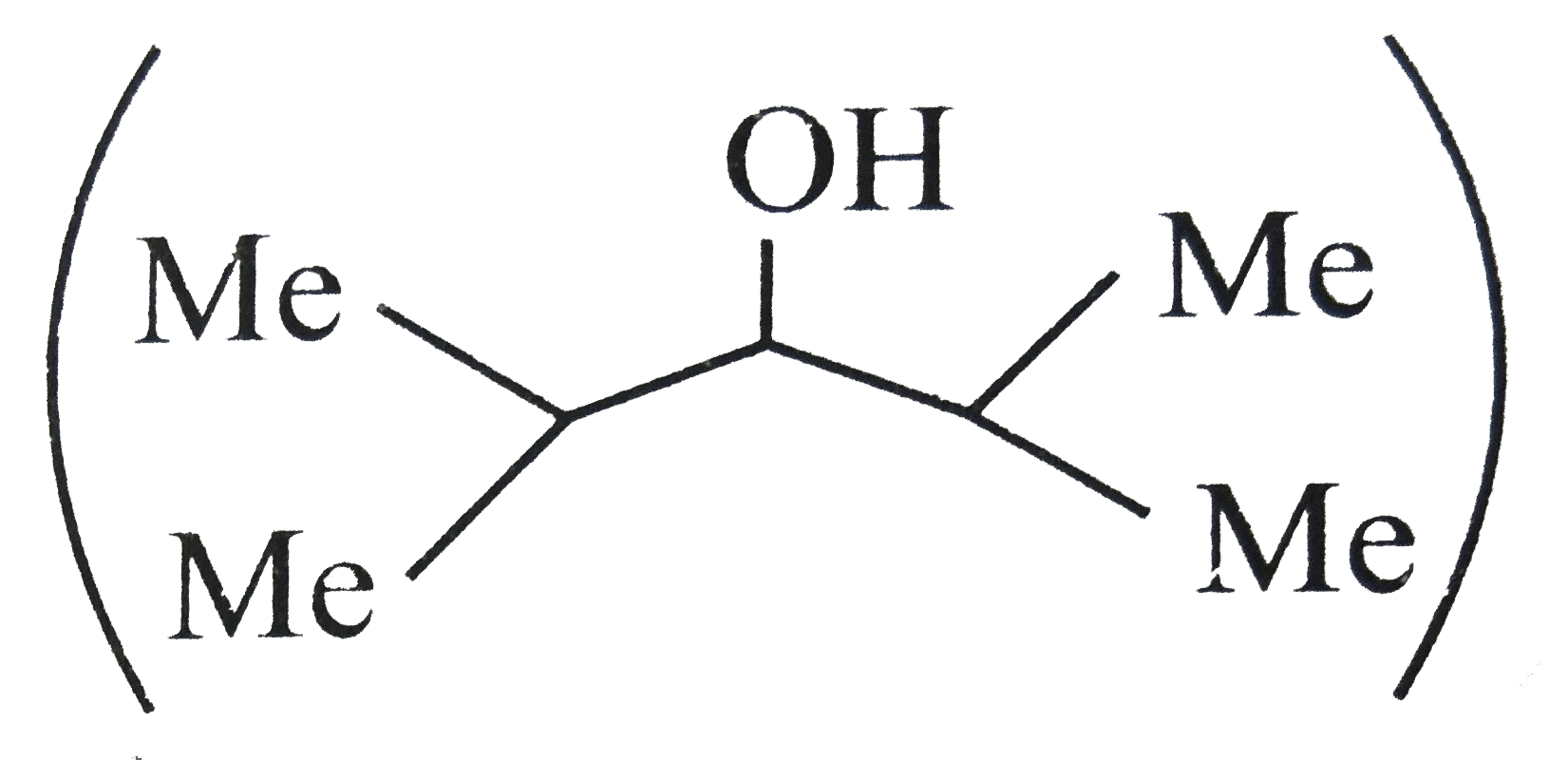The adduct of a compound (A) with isopropyl magnesium halide on hydrolysis gives a tertiary alcohol. The compound (A) is:
An ester
A secondary alcohol
A primary alcohol
An aldehyde
The correct Answer is:A
To solve the problem, we need to identify the compound (A) that reacts with isopropyl magnesium halide (a Grignard reagent) to form a tertiary alcohol upon hydrolysis. Here’s a step-by-step solution:
Step 1: Understand the Reaction
The reaction involves a Grignard reagent (isopropyl magnesium halide) reacting with a compound (A) to form an adduct. Upon hydrolysis, this adduct yields a tertiary alcohol.
Hint: Grignard reagents typically react with carbonyl compounds (aldehydes or ketones) to form alcohols.
Step 2: Identify the Type of Compound (A)
Since the product is a tertiary alcohol, we need to consider that the Grignard reagent adds to a carbonyl compound. Tertiary alcohols are formed when a Grignard reagent reacts with a ketone or an aldehyde that has two alkyl groups already attached to the carbonyl carbon.
Hint: Tertiary alcohols require a carbonyl compound that can accommodate the addition of two alkyl groups.
Step 3: Analyze the Grignard Reagent
The Grignard reagent in question is isopropyl magnesium halide, which has the structure (CH3)2CHO-. This means that it has two methyl groups and one isopropyl group, making it a good candidate for forming a tertiary alcohol when it reacts with a suitable carbonyl compound.
Hint: Isopropyl magnesium halide will add to a carbonyl compound to form a tertiary alcohol.
Step 4: Determine the Carbonyl Compound
To form a tertiary alcohol, we need a carbonyl compound (A) that, when reacted with isopropyl magnesium halide, results in a tertiary alcohol. The simplest carbonyl compound that can achieve this is an aldehyde or a ketone.
- If we consider an aldehyde, it should be one that can provide the necessary carbon skeleton to form a tertiary alcohol after the reaction.
- A common aldehyde that can be used is acetaldehyde (CH3CHO). However, this would yield a secondary alcohol, which is not what we want.
Hint: Look for a carbonyl compound that allows for the formation of a tertiary alcohol.
Step 5: Choose the Correct Compound (A)
The correct compound (A) must be a carbonyl compound that, when reacted with isopropyl magnesium halide, leads to a tertiary alcohol. The best candidate is formaldehyde (HCHO), which upon reaction with isopropyl magnesium halide will yield a tertiary alcohol.
Hint: Formaldehyde is the simplest aldehyde and can lead to the formation of a tertiary alcohol when reacted with a Grignard reagent.
Step 6: Conclusion
Thus, the compound (A) that reacts with isopropyl magnesium halide to form a tertiary alcohol upon hydrolysis is formaldehyde (HCHO).
Final Answer: The compound (A) is formaldehyde (HCHO).
The reaction involves a Grignard reagent (isopropyl magnesium halide) reacting with a compound (A) to form an adduct. Upon hydrolysis, this adduct yields a tertiary alcohol.
Since the product is a tertiary alcohol, we need to consider that the Grignard reagent adds to a carbonyl compound. Tertiary alcohols are formed when a Grignard reagent reacts with a ketone or an aldehyde that has two alkyl groups already attached to the carbonyl carbon.
The Grignard reagent in question is isopropyl magnesium halide, which has the structure (CH3)2CHO-. This means that it has two methyl groups and one isopropyl group, making it a good candidate for forming a tertiary alcohol when it reacts with a suitable carbonyl compound.
To form a tertiary alcohol, we need a carbonyl compound (A) that, when reacted with isopropyl magnesium halide, results in a tertiary alcohol. The simplest carbonyl compound that can achieve this is an aldehyde or a ketone.
- A common aldehyde that can be used is acetaldehyde (CH3CHO). However, this would yield a secondary alcohol, which is not what we want.
The correct compound (A) must be a carbonyl compound that, when reacted with isopropyl magnesium halide, leads to a tertiary alcohol. The best candidate is formaldehyde (HCHO), which upon reaction with isopropyl magnesium halide will yield a tertiary alcohol.
Thus, the compound (A) that reacts with isopropyl magnesium halide to form a tertiary alcohol upon hydrolysis is formaldehyde (HCHO).
Topper's Solved these Questions
- HALOALKANES & HALOARENES Book:VMC MODULES ENGLISHChapter:HALOALKANES & HALOARENES Exercise:IMPECCABLE
Explore 100 Videos
- HALOALKANES & HALOARENES Book:VMC MODULES ENGLISHChapter:HALOALKANES & HALOARENES Exercise:ENABLE
Explore 99 Videos
- ENVIRONMENTAL CHEMISTRYBook:VMC MODULES ENGLISHChapter:ENVIRONMENTAL CHEMISTRYExercise:JEE Main (Archive)
Explore 39 Videos
- HALOALKANES AND HALOARENESBook:VMC MODULES ENGLISHChapter:HALOALKANES AND HALOARENESExercise:IN-CHAPTER EXERCISE - F
Explore 6 Videos
Similar Questions
Knowledge Check
A cyanohydrin of a compound X on hydrolysis gives lactic acid. The X is
AHCHOBCH3CHOC(CH3)2CODC6H5CH2CHO
Which of the following alkyl halides on hydrolysis gives a glycol?
View SolutionPropyl ester reacts with isopropyl magnesium bromide to give 2∘ alcohol
 The ester is :
The ester is :
View SolutionPropyl lithium reacts with ethene to give a compound (A), which on reaction with methanal followed by acidic hydrolysis gives compound (B). The compound (B) is :
View SolutionThe reaction of methyl magnesium iodide with acetone followed by hydrolysis gives secondary butanol.
View SolutionFormaldehyde when reacted with methyl magnesium bromide followed by hydrolysis gives
View SolutionWhich of the following compounds has isopropyl group?
View SolutionReaction between acetone and methyl magnesium chloride followed by hydrolysis will give:
View Solution
